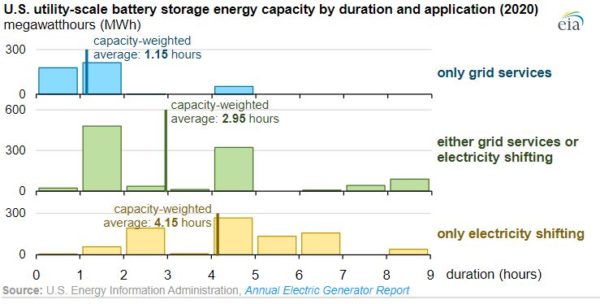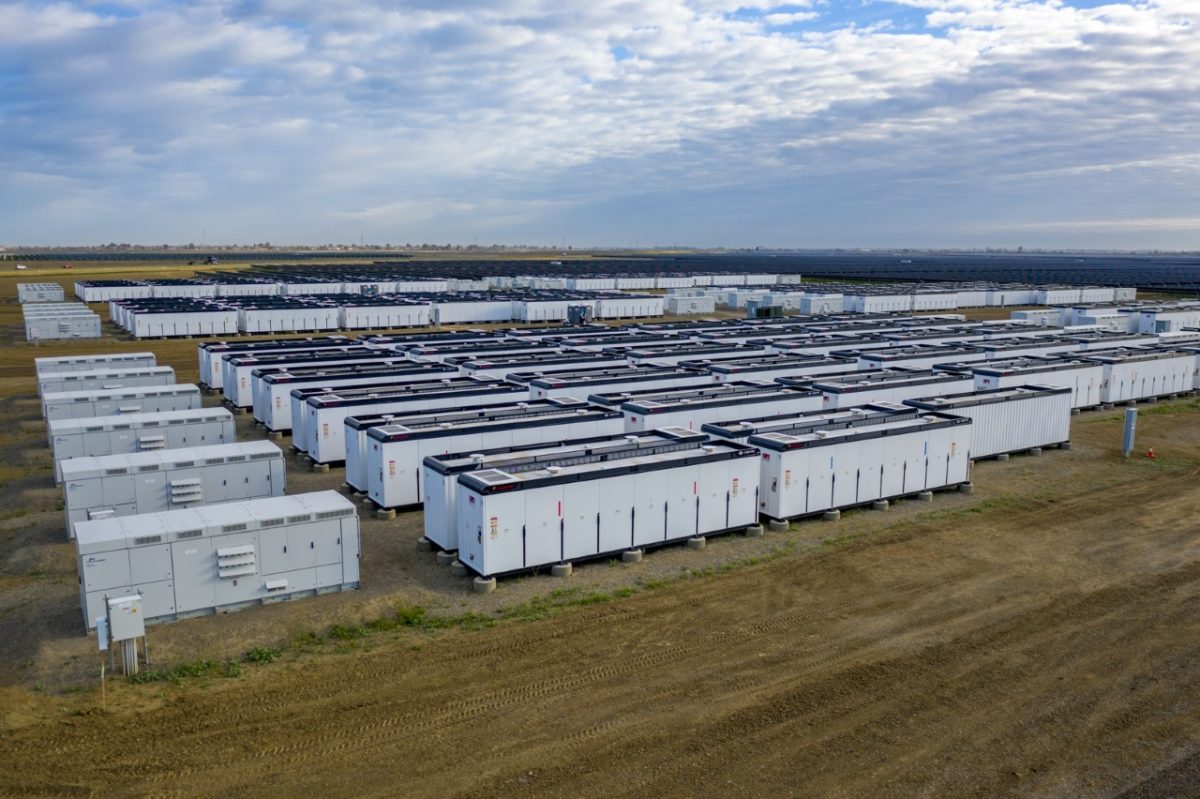The Energy Information Administration (EIA) reports the United States had a 4.5GW total capacity of energy storage by the end of 2021. The wellspring of storage development has come in response to a variety of beneficial grid services storage can provide, especially when paired with renewable energy. In fact, EIA reports more than 60% of upcoming battery capacity will be co-located with solar PV systems.
Energy storage duration refers to the amount of time a battery or other energy storage system can dispatch energy from a full charge until it is depleted. Most batteries on the grid today range from an hour or less to four-plus hours, and there are some outliers that can provide continuous power for 12 hours or more.
Duration has largely been found to be tied to the function the storage system provides, according to EIA. EIA categorizes battery functions in two main buckets: grid services and electrical load shifting. Grid services, which entail dispatching power for brief periods, sometimes for minutes or even a few seconds, help maintain grid stability and reliability. Electrical load shifting involves shifting electricity from times of low demand to times of high demand. This service is particularly important when paired with the diurnal generation of solar energy.

The grid services-only segment averages 1.15 hours in duration. Hybrid, dual-service storage averages 2.95 hours, and electric load shifting-only batteries average 4.15 hours.
More than 40% of US battery energy storage can perform both grid services and load shifting activities. About 40% performed load shifting activities, and the remaining 20% performed only short-duration grid dispatch services.
In the late 2010s, the bulk of the energy storage added to the grid was focused on short-duration services, but as solar energy becomes an increasing feature of the grid, longer-duration load shifting services are coming under focus. Most co-located solar and energy storage systems feature a battery with durations of four hours or more.
Innovation and growth outlook
EIA forecasts that by the end of 2023, energy storage deployment across the nation will have more than doubled from current levels to about 10GW. With this growth comes a host of innovative opportunities.
In the US, lithium-ion batteries are the dominant source of both short and long duration storage, but other chemistries and designs are being actively considered, especially in the long duration use case. pv magazine has covered developments in lithium-ferro-phosphate batteries, sodium-ion batteries, flow batteries, and other atypical designs like compressed air energy storage, iron-air energy storage systems that rely on oxidation, and gravity-based energy storage towers.
At last November’s COP26 climate summit, a long-duration energy storage consortium was formed. The consortium estimates between 85 and 140 terawatt-hours of LDES deployment will be required to achieve a net-zero grid by 2040. The council also estimates a need of 1 TWh of LDES deployment by 2025 to pace for decarbonization by 2040.
These deployment projections would entail a $1.5 to $3 trillion investment. The council said renewable energy stored in these technologies could eliminate 1.5 to 2.3 Gigatons of carbon dioxide emissions, or about 10-15% of global power emissions.
If these emissions reduction targets are to be achieved, there must be carbon-free energy charging the batteries. The world will need 5.2TW of solar power generation capacity by 2030, and 14TW by mid-century, to have any chance of limiting global average temperature rises this century to 1.5 degrees Celsius, according to the International Renewable Energy Agency (IRENA).
The world will have to install 450GW of new solar capacity each year – most of it utility scale – for the rest of this decade, with China and India to lead Asia to a roughly half share of the world’s installed PV capacity in 2030, the report’s authors estimated.
Based on current deployment levels, IRENA director-general Francesco La Camera, recently wrote, “Progress across all energy uses has been woefully inadequate.”
This content is protected by copyright and may not be reused. If you want to cooperate with us and would like to reuse some of our content, please contact: editors@pv-magazine.com.









“Most co-located solar and energy storage systems feature a battery with durations of four hours or more.”
Hmmm… Why not co-locate storage with wind? Do you ever wonder why this isn’t happening? Perhaps it’s because solar farm developers are gaming the ITC to make solar+storage projects more competitive than solar projects alone? I don’t know for sure but this is what a solar developer told me. You really have to wonder why the developers keep screaming for the ITC to get extended when it only changes the LCOE of solar by a fraction of a cent. I think we should be directing these sorts of tax credits towards clean technologies that deliver more bang for the buck? EVs and heat pumps come to mind.
Why is there so much focus on storage when you can charge up EVs or heat stuff with the extra electricity? What is the allure? It’s weird.
If you look at the EIA’s data for the Usage Factors of grid batteries you see a rather steep downward trend.
2017 – 6.8%
2018 – 5.2%
2019 – 5.4%
2020 – 5.2%
2021 – 4.6%
This isn’t a good trend especially when you consider that the shift to longer durations should be increasing usage factors. If batteries are a smart investment why are we seeing usage factors decline? If you investigate wholesale electricity prices you’ll find that the delta between low load and high load hours isn’t consistently large enough to pay for arbitrage. It doesn’t take a wizard to see that increasing amounts of RE and flexible loads are going to push the average wholesale price down AND squeeze the price delta between high and low price hours. This is going to make it harder and harder for grid storage to play arbitrage. I don’t see the current dynamics going away.
We shouldn’t be wasting trillions on grid storage when dynamic prices and flexible loads can do the same job at a fraction of the price. All these reports from the IEA, the UN, IRENA etc say we need to speed up the deployment of clean energy technologies. I think the best way to do this is to make clean energy more affordable than dirty technologies. Grid batteries don’t fit into this strategy.
Isn’t the grid storage to take the place of peaker plants? What is the usage factors of peaker plants. There is a need for a means to meet the peak loads or one can accept curtailment. Though gas-fired peaker plants can also serve as a long duration backup should some of the main generator plants shut down for whatever reason whereas batteries may not.
Hi John,
I operate power plants for a living and I don’t really know what the functional objective of the storage is. Arbitrage is my best guess (for the 4 hour projects) but reality doesn’t support this guess. One thing I do know is that if you bribe politicians and throw subsidies at project developers you’ll get projects. Look at the CSP projects (technically awesome but white elephants) and all the nonsense fuel cell projects (fraud). At the federal level look at ethanol.
If batteries were meant to be peaker (which makes some sense) we should see these plants a lot more often. For comparison, pumped hydro has operated in the 10 to 12% range over the last decade.
Peaker plants generally run about 10 to 15% of the time. Over the last 10 years, the capacity factor has ranged between 8.3% and 12.1% in the US. Research from Dr. Marc Perez and others suggests that it’s far cheaper to accept curtailment than use grid storage to meet most peak loads.
It’s true that gas plants can have problems… All plants, can and do, fail… Batteries plants included – See Moss Landing.
https://www.energy-storage.news/worlds-biggest-lithium-battery-storage-facility-now-completely-offline-after-weekend-incident/